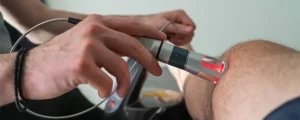What is Shockwave Therapy and How Does It Work?
Shockwave therapy is a non-invasive treatment that uses acoustic waves to promote healing and reduce pain. So how does shockwave therapy work? The process involves sending high-energy sound waves into the affected area of your body. These waves stimulate circulation and encourage tissue regeneration. This means that whether you’re dealing with chronic pain or trying to recover from an injury, shockwave therapy could be a viable option for you.
The Benefits of Shockwave Therapy
Shockwave therapy has been gaining traction in the medical community, and for good reason. Here’s a straightforward list of its benefits that might just convince you to consider this innovative treatment:
Pain Relief: One of the most significant advantages is its ability to reduce pain. Patients often report a noticeable decrease in discomfort after just a few sessions.
Improved Mobility: Many people find that shockwave therapy helps restore their range of motion, making it easier to perform daily activities without restrictions.
Non-Invasive Treatment: Unlike surgery, shockwave therapy is non-invasive, which means no lengthy recovery times or hospital stays.
Quick Sessions: Each treatment session typically lasts only 15-30 minutes, making it easy to fit into even the busiest schedules.
Minimal Side Effects: Most patients experience little to no side effects, with some mild soreness being the most common complaint post-treatment.
Stimulates Healing: Shockwave therapy promotes blood flow and stimulates cellular repair processes, helping speed up recovery from injuries.
Versatile Applications: It’s effective for various conditions—from tendonitis and plantar fasciitis to sports injuries—making it a go-to option for many practitioners.
Long-Lasting Results: Many individuals enjoy lasting relief from their symptoms after completing their recommended treatment plan.
Common Conditions Treated with Shockwave Therapy
Plantar Fasciitis: This painful foot condition is often alleviated through shockwave therapy, which helps reduce inflammation and promote healing.
Tendinitis: Whether it’s in the shoulder, elbow, or Achilles tendon, shockwave therapy can provide relief by breaking down scar tissue and stimulating blood flow.
Patellar Tendinopathy: Commonly known as “jumper’s knee,” this condition sees great improvement with shockwave therapy that encourages tissue regeneration.
Trigger Points/Myofascial Pain Syndrome: If you’re struggling with tight knots in your muscles, shockwave therapy can help release these trigger points and relieve discomfort.
Achilles Tendonitis: Athletes often face this issue, but shockwave therapy can speed up recovery by enhancing circulation to the affected area.
Bursitis: Inflammation of the bursa around joints can be painful; shockwave therapy helps reduce inflammation and promote healing.
These are just some of the common conditions where shockwave therapy shines as an effective treatment option! Always consult with a healthcare professional to see if it’s right for you.
Is Shockwave Therapy Right for You?
In conclusion, whether shockwave therapy is right for you really boils down to your unique situation and pain management needs. If you’re tired of living with chronic pain or discomfort and have tried various treatments without success, it might be time to consider this innovative option. Shockwave therapy has shown promising results for many people, offering a non-invasive way to promote healing and reduce pain.
Before diving in, it’s essential to consult with a qualified healthcare professional who can assess your condition and guide you through the process. They’ll help determine if shockwave therapy aligns with your health goals and needs.
.







